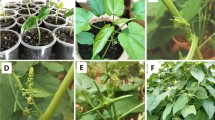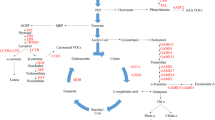Abstract
Using four populations of the liliaceous perennial Erythronium japonicum, I examined the hypothesis that sex allocation will be female-biased if the duration of sink-limited growth of fruits, during which fruits grow exponentially, is long. I found that all marked fruits in each population had a period of sink-limited growth. Among the four populations, the mean length of sink-limited growth increased, and the mean dry mass ratio of the sum of the corolla and androecium/fruit decreased, in a consistent order. Thus, plants in populations where the duration of sink-limited growth was long allocated relatively more of their resources to their female functions. This result was consistent with the above hypothesis.
Similar content being viewed by others
Author information
Authors and Affiliations
Additional information
Received: 21 March 1998 / Accepted: 27 August 1998
Rights and permissions
About this article
Cite this article
Sakai, S. Female-biased sex allocation in relation to growth rate of fruit in Erythronium japonicum . Oecologia 117, 391–395 (1998). https://doi.org/10.1007/s004420050672
Issue Date:
DOI: https://doi.org/10.1007/s004420050672




